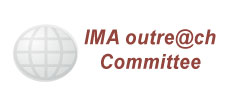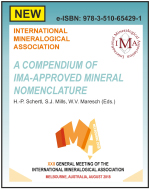Home page > Commissions, Working Groups & Committees > CAM
CAM
COMMISSION ON APPLIED MINERALOGY
IMA-CAM was initiated around 1979, after the creation of the International Council for Applied Mineralogy (ICAM). The aims of IMA-CAM are to co-ordinate or arrange conferences, symposia, seminars, or meetings devoted to applied mineralogy, to serve as a liaison body to other organizations active in the field, and to encourage interaction between applied mineralogists, particularly focusing on the areas of process mineralogy, applied mineralogy of ceramics, cements and glasses, development and application of advanced materials, environmental mineralogy and health, analytical techniques, mineral surfaces and nanoparticles.
Since the ICAM meeting in Perth 1993, it was decided to hold ICAM meetings on a quadrennial schedule at exactly half-way between the IMA meetings. In addition, ICAM and IMA-CAM decided of jointly sponsoring sessions organized by one or the other at ICAM and IMA Meetings. The objectives of CAM was revisited during the Kobe business meeting (see 2006 report).
A handbook for CAM was prepared by Dogan Paktunc. It was accepted by the IMA council in Davos (July 2009).
With the establishment of a new subcommission on Geometallurgy, in 2009, CAM plans to lead and coordinate the development of reference and standard materials for quantitative mineralogy and geometallurgy. A handbook for the CAM was prepared by Dogan Paktunc. It was accepted by the IMA council in Davos (July 2009). CAM 2010 annual report prepared by Megan Becker (10 January 2011).
IMA-CAM was initiated around 1979, after the creation of the International Council for Applied Mineralogy (ICAM). The aims of IMA-CAM are to co-ordinate or arrange conferences, symposia, seminars, or meetings devoted to applied mineralogy, to serve as a liaison body to other organizations active in the field, and to encourage interaction between applied mineralogists, particularly focusing on the areas of process mineralogy, applied mineralogy of ceramics, cements and glasses, development and application of advanced materials, environmental mineralogy and health, analytical techniques, mineral surfaces and nanoparticles.
Since the ICAM meeting in Perth 1993, it was decided to hold ICAM meetings on a quadrennial schedule at exactly half-way between the IMA meetings. In addition, ICAM and IMA-CAM decided of jointly sponsoring sessions organized by one or the other at ICAM and IMA Meetings. The objectives of CAM was revisited during the Kobe business meeting (see 2006 report).
A handbook for CAM was prepared by Dogan Paktunc. It was accepted by the IMA council in Davos (July 2009).
With the establishment of a new subcommission on Geometallurgy, in 2009, CAM plans to lead and coordinate the development of reference and standard materials for quantitative mineralogy and geometallurgy. A handbook for the CAM was prepared by Dogan Paktunc. It was accepted by the IMA council in Davos (July 2009). CAM 2010 annual report prepared by Megan Becker (10 January 2011).
ICAM 2011
Next ICAM meeting will be held 1-5 August 2011 in Trondheim, Norway. Maarten Broekmans who is CAM’s sub-commission chair on building materials will serve as the chair of the scientific committee and editor in chief. The official congress website (www.icam2011.org) was launched and first official circular for ICAM 2011 was distributed in November 2009. The Geological Survey of Norway has also signed a Memorandum of Understanding with the ICAM council (Ying Gu) and has hired a local PCO. Conference venue has also been arranged.
ICAM will also host pre-congress workshops. The short course proposed by Broekmans and approved by the MSA, will comprise a 2-day workshop titled "Applied mineralogy of cement and concrete". Herbert Pöllmann has agreed to be the co-convener. Short course notes to be published in Reviews in Mineralogy and Geochemistry series. Further information available at www.minsocam.org/MSA/SC/#Cement. Post-ICAM conference excursion destinations ( 4) also to be selected by scientific committee. The coordinator for the excursions has yet to be assigned.
IMA General Meeting Sessions organized by CAM:
- Ceramics and advanced materials including glasses (Convenors: Hans-Joachim KLEEBE, Pavol ŠAJGALÍK, Aleksander RE?NIK)
- Archaeometry (general session): Composition, technology and provenance of archaeological artifacts (Convenors: Corina IONESCU, Isabella MEMMI-TURBANTI, Cristina BELLELLI)
- Mineralogy of mine wastes and contaminated soil (co-organized with IMA Working Group on Environmental Mineralogy and Geochemistry - Convenors: Dogan PAKTUNC and David VAUGHAN)
- Biominerals and biomaterials: The interface between geosciences and life sciences (Convenors: Robert B. HEIMANN, Jaroslav ŠESTÁK, Eugenia VALSAMI-JONES)
Short course during the IMA General Meeting: Eric Pirard (CAM) is organizing a post-congress short course entitled "Quantitative Image Analysis of Minerals and Rocks" to be held 28-29 August 2010.
ICAM 2008 : 9th International Congress for Applied Mineralogy, 8-10 September 2008, Brisbane, Australia
An initiative of The Australasian Institute of Mining and Metallurgy, CSIRO and JKTech. Website : http://www.icam2008.com/
The Congress covered applied mineralogy in the broadest sense and will be an excellent opportunity for the presentation of the latest basic and applied research results and state-of-the-art overviews by international specialists. Applied mineralogy embraces numerous applications of mineralogy in the mineral, metallurgical, chemical and materials industries, as well as in waste recycling, environmental assessment and medicine. As an interdisciplinary field, it involves characterisation of a wide variety of crystalline materials including ores, mineral concentrates, engineering materials, biomaterials and industrial residues. The main Congress themes included:
- Advanced materials Analytical techniques and automated instrumentation
- Applied mineralogy in precious metals
- Biominerals and biomaterials
- Cement and construction materials
- Ceramics and glasses
- Cultural heritage Don Hausen
- Environmental and medical mineralogy
- Geometallurgy and process mineralogy
- Industrial minerals, including gems
- Mineral exploration
- Oil reservoirs Ore.
mineralogyCongress Chair: Dr Ying Gu, JKMRC, Brisbane Australia
Key submission dates: Abstracts submitted by the 16th of November 2007 Notification of acceptance in January 2008
Announcement of a workshop during the ICAM Conference
IMA-CAM Workshop Quantitative Mineralogy Sep 6, 2008, Brisbane, Australia
ICAM 2008 Objectives
1) To bring together the experts, service providers, developers and end users (e.g. mineral processing engineers, mineralogists, geologists and metallurgists) for a review of the applications, progress and challenges in quantitative mineralogy including determination of modal mineralogy and mineral liberation;
2) To review the needs in the fast emerging field of quantitative mineralogy including standardization of techniques, quality control, uncertainties in the measured parameters, sample size and reference materials;
3) To suggest and/or develop an action plan that will address the key gaps and future needs in this field; 4) To facilitate the establishment of a network of expertise on quantitative mineralogy.
Workshop Plan
Introduction to Workshop Session 1 Plenary presentations Session 2 Breakout Group discussions Session 3 Plenary - Breakout Group presentations Session 4 Plenary - Findings and recommendations Materials and method
The workshop included several plenary presentations by invited experts aimed at providing context and an update on current research and developments. The workshop participants will be assigned to one of following breakout groups.
1) Tools and approaches (equipment and software) - Service providers, developers 2) Needs in geometallurgy, process control, mill improvements/audits, exploration, development - End users: metallurgists, geologists, mineralogists, plant operators
3) Limitations, uncertainties, standardization – Developers, experts, end users Following breakout group discussions, each group presented their findings to the Workshop in plenary. The Workshop culminated with an overview of the findings and recommendations for future directions and follow-up work.
School on Synchrotron X-ray and IR Methods Focusing on Environmental Sciences
Announcement of a short course (from D. Paktunk - 19 October 2007): When: 21-23 January 2008 Where: Synchrotron Radiation Source ANKA, Forschungszentrum Karlsruhe, Eggenstein-Leopoldshafen, Germany Who: Institute for Synchrotron Radiation, supported by EU N2 Networking Activity (I3 Project IA-SFS) and European X-ray Spectrometry Association
CAM will be participating in RILEM’s (Réunion Internationale des Laboratoires et Experts des Matériaux, Systèmes de Constructions et Ouvrages) technical committee on Alkali-aggregate Reactions in Concrete Structures. This committee deals with the assessment and appraisal of existing alkali-silica reactivity (ASR) in concrete structures.
IMA-CAM short course: "Metals in the Earth: from vital resource to environmental hazard". Venues considered include IGC 2008 meeting in Oslo and Goldschmidt 2008 meeting in Vancouver. in collaboration with IMA-COM and IMA WGEMG.
IMA-CAM short course: Microscopía Cuantitativa y control de procesos minerals" is being organized by Eric Pirard. It was held in 2008 (24-28 March) at Universidad Catolica del Peru in Lima, Peru and feature an overview of optical and electron microscopy, image analysis and case studies in process mineralogy.
ICAM 2011
Next ICAM meeting will be held 1-5 August 2011 in Trondheim, Norway. Maarten Broekmans who is CAM’s sub-commission chair on building materials will serve as the chair of the scientific committee and editor in chief. The official congress website (www.icam2011.org)
ICAM will also host pre-congress workshops.
1. The Workshop organized by CAM in Brisbane, Australia during the International Congress for Applied Mineralogy (ICAM) meeting was a success. Following the meeting, a steering committee was created to oversee the follow-up activities. Details on the workshop and other related informations may be found within a document titled "workshop" on the Dogan Paktunc’s website pages. "Workshop notes and findings " 2. Henrique Kahn, Secretary of the CAM, has decided to resign from his position. He was a CAM officer since the 14th of August, 1993. All the IMA persons, and more especially the IMA Council, thank him a lot for its long investment in IMA scientific activities as a chair of the CAM. 3. The ICAM meetings will occur every three years instead of four. This will allow an easier participation of the IMA-CAM in the IMA General Meetings and vice versa, some IMA commissions and Working Groups could be more involved in the ICAM meetings. 4. The next ICAM meeting will occur in Trondheim, Norway, in 2011. Marteen Broekmans was elected Vice-President of the next ICAM meeting.
Next Business Meeting in Budapest, August 2010
See the CAM 2009 report for informations on CAM activities in 2009 and projects in 2010 and 2011.
Informations on the workshop held during the ICAM meeting, in Brisbane, 2008 is available at the following address: "Workshop notes and findings "
A Secretary of the CAM, Megan Becker, was named in June 2009 after proposal by the chair of CAM. A new sub-commission on Metallurgy and Quantitative Mineralogy was accepted by the IMA council after proposal by the chair of CAM. CAM has also established a new chair in geometallurgy which has been filled by Professor Dee Bradshaw from the Julius Krutschnitt Mineral Research Centre at the University of Queensland in Australia.
With the establishment of a new subcommission on geometallurgy, CAM plans to lead and coordinate the development of reference and standard materials for quantitative mineralogy and geometallurgy. With the appointment of two new members onto the committee who are both based in the southern hemisphere, CAM also intends to try and extend its influence and activities into Australia and South Africa where geometallurgy and process mineralogy are thriving in collaboration with the mining and mineral processing industries.
Dee Bradshaw and Megan Becker run a course in process mineralogy for the mining industry (23-27 November 2009) hosted by the University of Cape Town
Dogan Paktunc organized and chaired a special session on the geochemical aspects of mine wastes during 24th International Applied Geochemistry Symposium (IAGS 2009) in Fredericton, Canada
2008 - A handbook for CAM was prepared by Dogan Paktunc. It was accepted by the IMA council in Davos 2009. 2006 - 2007 Following the Kobe meeting, flyers will be prepared and distributed at various conferences and meetings including Frontiers in Mineral Sciences 2007, Goldschmidt 2007, EMABM 2007, ICAM 2008, IGC 2008 and ICAAR 2008.
CAM officers are looking for appointment of sub-commission chairs for the (1) mineral exploration and mine development and (2) medical mineralogy and biomaterials sub-commissions. They are also looking for funding the CAM website.
Publication in Elements in 2005, V1-5: From the Chairman of the Commission on Applied Mineralogy, Richard Hagni




